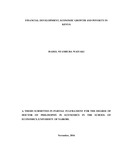| dc.description.abstract | It is evident that the financial sector in Kenya has grown rapidly in the last decade. However, the economy has had a low fluctuating growth and poverty levels have remained rampantly high. The effect of financial development on economic growth and poverty and especially the efficiency and quality aspects of financial sector development have been ignored. Again, Kenya‘s financial sector is more advanced compared to other African countries but the factors explaining this disparity have not been examined. This study, therefore, aimed at filling this research gap. The core objectives of the thesis were to determine the drivers of financial development and to determine the effect of financial development on economic growth and poverty. The novelity of the study findings arise from controlling for financial innovations, using appropriate measures of financial development and poverty incorporating the efficiency and quality aspects of financial development. Autoregressive Distributed Lag Model, Granger causality, cointegration analysis and Vector Error Correction Model were used for analysis using quarterly time series data for the period 2000 to 2014.
This study found that credit to private sector model which shows level of intermediation in the financial sector supported the openness hypothesis indicating the importance of trade openness for financial development. The non-performing loans model which captures the quality of credit and efficiency in the financial sector supported the economic institutions hypothesis by stressing the importance of institutional quality for financial development. Other key determinants were GDP, political economy and mobile technology.
Further findings showed that financial development incorporating the efficiency and quality aspects as indicated by non-performing loans and interest rate spread had a positive effect on economic growth. Still, financial development directly reduces poverty in Kenya while it also indirectly reduces poverty through economic growth thus confirming the trickle down hypothesis of growth on poverty reduction. Additionally, the recent financial innovations were found to increase growth and also reduce poverty. The main channels through which financial innovation contributed to growth and poverty reduction included the transfer, credit and savings channels. Financial development was predominantly seen to granger-cause economic growth thus supporting the supply leading hypothesis.
Based on the findings, the study made the following policy recommendations. There should be improvement in the quality of legal, economic and political institutions by the government. A more democratic environment with a system of political checks and balances should be maintained. The government should have trade policies to grow the volume of trade. Growth of financial innovations should be supported by creating a conducive environment by the regulatory bodies, government and other institutions. The efficiency and quality of the financial sector should be improved with interest rate reforms to reduce the interest rate spread and reduction of non-performing loans. This ought to include policies to monitor credit to private sector. Finally, economic growth should be targeted through innovations and other measures like maintaining a good macro economic environment while encouraging a more inclusive growth to reduce poverty. | en_US |



